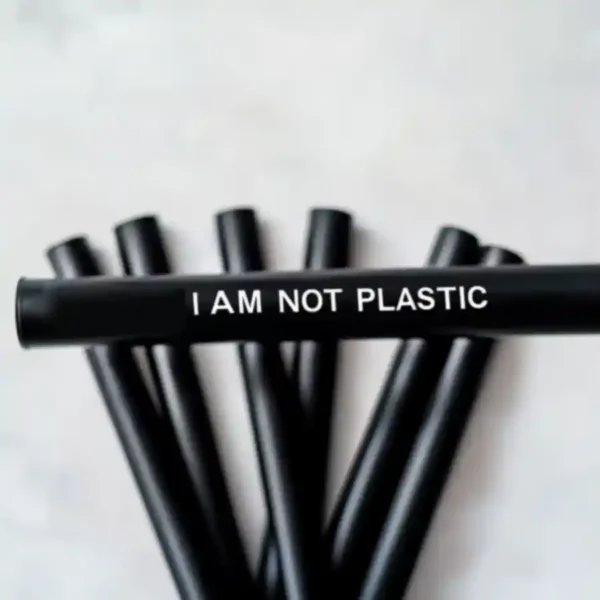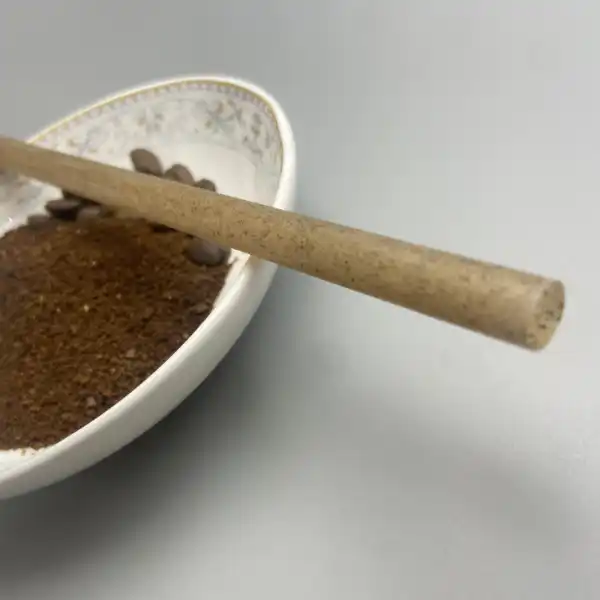Invoering
The growing awareness of plastic pollution and its detrimental effects on our environment has led to a significant shift in consumer preferences toward sustainable products. In fact, 46% of consumers have a more favorable opinion of an advertiser if the promotional product they received was environmentally friendly. This trend highlights the importance for businesses to adopt eco-friendly alternatives. Custom-branded eco-friendly straws offer a practical solution, allowing you to promote your brand while demonstrating a commitment to environmental responsibility. This article provides a comprehensive guide on effectively customizing eco-friendly straws with your brand logo, enabling you to enhance your brand image and contribute to a more sustainable future.

Why Your Business Needs Custom Eco-Friendly Straws
- Merkherkenning: Personalized straws serve as a continuous reminder of your brand to customers each time they use them. This consistent exposure can significantly increase brand recognition and recall.
- Customer Experience: A unique, thoughtful touch, such as a custom-branded straw, can elevate the customer’s overall dining or event experience. This attention to detail can foster positive feelings toward your business and encourage repeat patronage.
- Marketing Tool: Custom straws function as a subtle yet effective marketing tool. When customers share photos of their beverages on social media, your brand gains additional exposure, expanding your reach. For more insights on leveraging custom straws for marketing, visit Rush Order Tees.
- Sustainability Statement: By choosing eco-friendly straws, your business demonstrates a commitment to environmental stewardship. This commitment can attract environmentally conscious consumers, which is important as 64% of consumers feel a brand’s social responsibility efforts are important to them.
- Versatility: Custom straws are suitable for various industries, including restaurants, bars, hospitality, and event planning. This versatility makes them a valuable marketing tool for reaching a diverse audience.
- Continuous Exposure: Since straws are frequently used in daily life, they provide continuous brand exposure, with 85% of consumers who receive promotional items remembering the advertiser.
Choosing the Right Eco-Friendly Straw Material
Selecting the appropriate material for your custom straws is crucial to ensure both sustainability and functionality. Here is an overview of eco-friendly options available:
Plant-Based Materials
- Rice Straws: These straws are made from rice starch and are edible, offering a traditional and natural look. They are sturdy and suitable for both hot and cold beverages. The production of rice straws involves a 6-step process from producing rice starch to quality checking.
- Coconut Straws: Made from coconut water by-products, these straws have a unique texture and are ideal for tropical-themed drinks.
- Koffie rietjes: These straws are made from coffee grounds and impart a subtle coffee aroma, enhancing the drinking experience for coffee lovers.
- Rietjes van suikerriet: Durable and strong, sugarcane straws are well-suited for thicker beverages like smoothies. Explore Nature Bio Eco’s sugarcane straws for customizable options.
- Grass Straws: Lightweight and natural, grass straws are perfect for cold drinks and cocktails.
- Cellulose-Based Straws: These straws, derived from plant fibers, are fully compostable and biodegradable, and they are capable of handling both hot and cold beverages.
- PHA-Based Straws: Made from microbial fermentation of organic materials, PHA straws are 100% compostable and marine-degradable.

Other Materials
- Papieren rietjes: While a common alternative to plastic, paper straws may become soggy and some may contain chemicals.
- Roestvrijstalen rietjes: These reusable straws are durable and often come in sets, offering a long-term sustainable option.
- Silicone Straws: Reusable and compact, silicone straws can come with carrying cases for added convenience.
- Tarwe rietjes: Another option for single-use straws, often available in sets and made from wheat byproducts.
- Recycled Plastic: While not compostable, using recycled plastic for straws helps to reduce the impact of existing plastic waste.
Material Comparison
Each material offers unique properties in terms of durability, reusability, compostability, and environmental impact. Plant-based options like rice, coconut, and PHA straws are excellent for compostability. Reusable options like stainless steel and silicone offer durability, while recycled plastic reduces waste.
Certifications
Look for certifications like BPI (Biodegradable Products Institute) or TÜV AUSTRIA to ensure that the straws are genuinely compostable and meet stringent environmental standards. Understanding Compostable & Biologisch afbreekbare rietjes from UrthPact can help verify product claims.
Home vs. Industrial Compostability
Home compostable straws break down in home compost systems, while industrial compostable straws require specific facilities. Home compostability offers a more accessible and practical approach for consumers.

Customizing Your Eco-Friendly Straws
Customization is key to making your eco-friendly straws a strong representation of your brand.
- Design Your Straw Wrap:
- A well-designed straw wrap is crucial for brand visibility.
- Incorporate your logo, slogan, and brand colors into the design to align with your brand’s identity.
- Use high-quality printing techniques to ensure the logo and colors are clear and easily recognizable.
- Select Colors:
- Color plays an important role in brand recognition.
- Use your brand’s primary and secondary colors to create a cohesive look.
- Consider unique options like color-changing straws, which change color when exposed to cold liquids.
- Add Your Logo or Slogan:
- Include your logo or slogan on the straws or their wrappers to enhance brand visibility.
- Ensure the placement is simple and elegant for maximum impact.
- Maintain readability and visual appeal by carefully considering the size and placement of the logo.
- Decoration Methods: Options for decoration include screen printing, pad printing, laser engraving, and heat transfer.

Types of Custom Straws Available
- Reusable vs. Single-Use: Reusable straws offer long-term use, while single-use options are often biodegradable or compostable. Biodegradable options are available for single-use straws, making them more eco-friendly.
- Straw Designs:
- Bent vs. Straight: These options cater to different preferences and uses.
- Cocktail Straws: Shorter in length, these are perfect for mixed drinks and cocktails.
- Standard Straws: A versatile choice for everyday beverages.
- Extra-Long Straws: Ideal for taller glasses and larger drinks.
- Boba-rietjes: These have a wider diameter to accommodate the pearls and toppings in bubble tea.
- Straw Sets:
- Many reusable straw sets include cleaning brushes for maintenance.
- Some sets come with carrying cases or pouches for convenient storage and transportation.
- Certain cases can even double as phone stands, adding extra functionality.
How to Order Custom Straws
Ordering custom straws is a streamlined process.

- Step-by-step guide:
- Select your desired product from a supplier’s catalog.
- Choose the product color that best suits your brand.
- Use the design studio to upload your artwork or create a design using available resources.
- Specify the quantity needed for your order.
- Select your preferred shipping method.
- Expert tip: Pair custom straws with branded reusable cups or tumblers to increase brand visibility and promote eco-friendly practices.
- Design studio: Many suppliers provide resources like design templates, fonts, and clip art to help you create a unique design.
- Limited Space: Be mindful of the limited space available on the straws for your logo or design.
- Expert Consultation: Expert consultants can assist with design placement to maximize visual impact.
- Shipping Options: Choose from rush shipping for faster delivery or free shipping for a more cost-effective option.
- Bulk Options: Ordering in bulk can help reduce costs and ensure you have an ample supply of branded straws. For bulk customization, consider Promos Promotional Products for a wide range of options.
Marketing and Branding Benefits
- Positive Brand Association: Using eco-friendly straws demonstrates your commitment to reducing plastic waste, creating a positive brand image.
- Reach a Diverse Audience: Custom straws cater to various industries, increasing your brand’s visibility and customer base.
- Increase Brand Visibility: Branded straws provide continuous brand exposure in everyday settings, enhancing recognition and loyalty.
- Consumer Preference: A significant percentage of consumers have a more favorable view of brands that use sustainable products.
- Brand Loyalty: Sustainable products can increase brand loyalty among eco-conscious customers.
- Long-Term Impact: Many consumers keep promotional products for an extended period, resulting in long-term brand exposure, with 40% keeping them for more than 10 years and 57% for more than 5 years.
- Promotional Campaigns: Utilize custom straws in marketing campaigns, at events, or as giveaways to increase brand reach and engagement.
Cost and Budget Considerations
- Pricing Options: There are branded straw options available to suit various budgets.
- Range: Prices range from under 50 cents per unit to over five dollars per unit for more elaborate reusable straw sets.
- Factors Affecting Cost: The material, order size, and customization methods used will influence the overall cost.

Practical Advice and Best Practices
- Start with a clear goal: Define your objectives for using custom straws and how they align with your marketing strategy.
- Plan Ahead: Start the design and ordering process early to ensure timely delivery.
- Partner with reliable suppliers: Choose suppliers who share your values and offer quality products. Consider GSM Paper Straw for custom printed options.
- Order samples: Request samples to assess the quality of the straws and customization before placing a bulk order.
- Provide clear disposal instructions: Educate your staff and customers on proper disposal methods, emphasizing composting where possible.
- Trial runs: Before placing large orders, conduct a trial run to gauge customer reactions and adapt to feedback.
Additional Information
- Manufacturing Process of Rice Straws: Rice straw production involves a 6-step process, from producing rice starch to packaging the finished straws.
- Longevity of rice straws: Rice straws have a shelf life of approximately 12 months and can be used for 15-30 minutes in hot water and 60-120 minutes in cold water.
- Environmental Stats: A high percentage of consumers have a more favorable view of brands that use sustainable products and are willing to spend more on sustainable products.
- Future Trends: Innovative sustainable designs and manufacturing methods for straws are continuously evolving.
- Address Common Concerns: Address common concerns about durability, taste, and effectiveness by selecting high-quality sustainable materials.
- Plastic Straw Bans: The growing trend of plastic straw bans is encouraging the use of sustainable alternatives.
Frequently Asked Questions (FAQ)
- What are the most popular eco-friendly materials for custom straws?
Common eco-friendly materials for custom straws include bamboo, PLA (polylactic acid), PHA (polyhydroxyalkanoates), rice, and coconut. Each material offers different environmental benefits, so it’s important to choose based on your sustainability goals. - How can custom eco-friendly straws benefit my brand?
Custom eco-friendly straws offer brand recognition, positive customer experiences, and a statement of social responsibility. They act as a subtle marketing tool while aligning your business with sustainability values. - Can custom eco-friendly straws be used for both hot and cold beverages?
Yes, many eco-friendly straw materials, such as bamboo, sugarcane, and PLA, are designed to handle both hot and cold drinks without losing their structural integrity. - How long do custom eco-friendly straws last?
The lifespan of eco-friendly straws varies based on the material. Bamboo and coconut straws are durable and reusable, while materials like rice and paper are typically intended for single-use but break down quickly in the environment. - Is marine-degradable the same as throwing a straw in the ocean?
Not exactly. Marine-degradable means it won’t harm the ocean long-term if it ends up there. However, proper disposal in compost or waste facilities is still best practice. - Where can I find reliable compostable straws?
Look for vendors that hold reputable certifications (e.g., BPI, TÜV AUSTRIA). You can also explore Nature Bio Eco’s customizable sugarcane straws for an eco-friendly option. - How can I ensure my custom straws are truly eco-friendly?
Verify certifications from organizations like BPI or TÜV AUSTRIA, choose materials that align with your sustainability goals, and work with reputable suppliers who prioritize environmental responsibility. - Do reusable straws require special maintenance?
Yes, reusable straws like stainless steel or silicone should be cleaned regularly to maintain hygiene. Many come with cleaning brushes or are dishwasher safe for easy maintenance.
External Links for Further Reading
- How to Customize Your Straws with Logos, Colors, and Designs
- Custom Straws with Logos For Your Brand
- Custom Reusable Straws with Logo – Design Custom Straws
- Custom Printed Paper Straws with Your Logo
- Top Tips for Getting Your Compostable Straws Customized
- Custom Reusable Straws with Your Logo
- Making Eco-Friendly Rice Straws: The 6-Step Process
- Understanding Compostable & Biologisch afbreekbare rietjes
- Custom Straws with Your Logo | Free Shipping
- Ultimate Guide to Choosing the Right Custom Straws
- Eco Straws Custom Brand
Disclaimer: The links and products mentioned are for illustrative purposes and do not constitute an endorsement. Always perform your own research before selecting a straw supplier or composting service.
By integrating custom eco-friendly straws into your business model, you not only promote your brand but also take a significant step toward environmental sustainability. Choose the right materials, collaborate with reliable suppliers, and educate your customers to maximize the benefits of this eco-friendly promotional tool.







